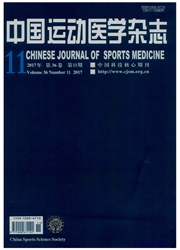

 中文摘要:
中文摘要:
目的:通过一次性不同时间的急性运动,探讨小鼠骨骼肌中核因子E2相关因子2(Nrf2)与抗氧化反应元件(ARE)结合活性随运动时间的变化。方法:将C57BL/6J野生小鼠,根据运动时间随机分为三组,分别是安静对照组(0h组)、1小时运动组(1h组)和6小时运动组(6h组);采取坡度为5%,速度为20m/min的跑台运动,运动结束后3小时取两侧骨骼肌。酶联免疫法(ELISA)测定骨骼肌细胞核中的Nrf2-ARE结合活性,Western Blot法测定骨骼肌核蛋白中Nrf2含量,实时荧光定量PCR测超氧化物歧化酶1(SOD1)、超氧化物歧化酶2(SOD2)、谷胱甘肽还原酶(GR)、γ谷氨酰半胱氨酸连接酶(GCLm)、谷胱甘肽过氧化物酶(Gpx1)和血红素加氧酶(HO-1)等基因的m RNA表达水平。结果:(1)Nrf2的结合活性1 h组与0 h组相比基本无变化,6 h组与0 h组相比显著性增加(P〈0.05);(2)核蛋白Nrf2的相对含量1 h组与0 h组相比基本无变化,6 h组与0 h组相比有增加的趋势但无显著性;(3)随着运动时间的增加,小鼠骨骼肌中GCLm、SOD1、SOD2、HO-1 m RNA相对表达量逐渐增高;Gpx1 m RNA相对表达量有增加的趋势但是无显著性;GR m RNA相对表达量无明显变化;与安静对照组相比,6 h组GCLm(P〈0.01)、SOD1(P〈0.01)、SOD2(P〈0.05)、HO-1(P〈0.01)m RNA相对表达量非常显著性或显著性增加。结论:(1)骨骼肌核蛋白Nrf2-ARE结合活性与运动时间呈正相关;(2)一次6小时长时间急性运动促进骨骼肌中Nrf2蛋白的核转位,显著增加核蛋白Nrf2-ARE的结合活性以及抗氧化酶GCLm、SOD1、SOD2、HO-1、Gpx1基因的m RNA水平。
 英文摘要:
英文摘要:
Objective To research the effect of acute exercise on the Nrf2-ARE binding efficacy in nuclearprotein of the skeletal muscle. Methods The C57BL/ 6J wild mice were randomly divided into control group(0 h),1-hour exercise group(1 h),and 6-hour exercise group(6 h). The mice in groups 1h and 6h were subject to motor-driven treadmill running for 1 hour and 6 hours respectively at the speed of 20m/min with 5% slope. The mice were sacrificed 3 hours after the exercise. The Nrf2 activation and the binding efficacy of Nrf2-ARE in the nuclear extracts of skeletal muscle were evaluated using a Trans AM Nrf2 Kit(ELISA). The expression of Nrf2 in nucleoprotein was analyzed by Western blot. SOD1,SOD2,GR,GCLm,and HO-1 m RNA in the skeletal muscle were measured by Real-time PCR. Result(1)Compared to the group0 h,the binding efficacy of Nrf2-ARE in group 6h increased significantly while remained unchanged in group1 h.(2)The expression of Nrf2 in nucleoprotein of groups 1h and 0h changed insignificantly and of group 6h tended to increase as compared with group 0h.(3)As increasing the exercise duration,GCLm,SOD1,SOD2,Gpx1,and HO-1 m RNA levels in the skeletal muscle increased except the GR m RNA. Compared to the group0 h,the GCLm,SOD1,SOD2,and HO-1 m RNA levels in the skeletal muscle of group 6h increased significantly. Conclusion(1)The Nrf2-ARE binding efficacy in the skeletal nucleoprotein of mice is positively coped with the duration of acute exercise.(2)6-hour acute exercise promotes the nuclear translocation,activation of Nrf2 and the transcription of its target genes.
 同期刊论文项目
同期刊论文项目
 同项目期刊论文
同项目期刊论文
 期刊信息
期刊信息
